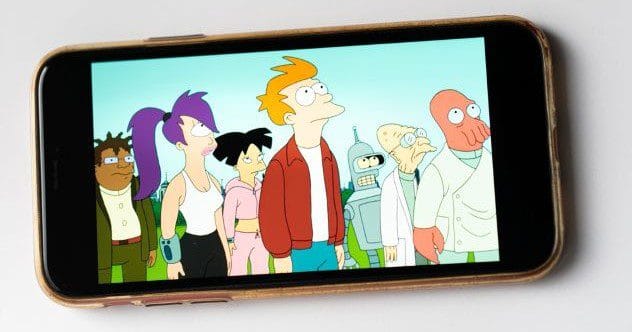In honor of Futurama, with its hilarious jokes and brainy writing, let’s explore some of my favorite science and math references in the show. Many of the writers on Futurama have advanced degrees in physics, math, computer science, and other fields. Together, they embed jokes throughout the show that only amuse those with a strong understanding of complicated subjects. Now, you, too, can learn something new and get a chuckle out of jokes you may not have caught before!
10. The Salmon Life Cycle
In Season 7 Episode 13, “Naturama,” the characters are featured in a three-part nature documentary called “Mutuals of Omicron’s Wild Universe.” Stepping away from the show’s penchant for mind-bending quantum physics, this episode explores ecological processes, including the salmon life cycle, tortoise mating rituals, and the social structures assumed by elephant seals. Although slightly less cerebral than other episodes of Futurama, had it not been for “Naturama,” I would have certainly passed my first biology quiz.
“Part 1: The Salmon” begins in a cold freshwater stream as salmon eggs begin to hatch among the gravel. The new hatchlings, known as alevins, are tiny fish connected to the yolk sac. Once they consume the yolk, they reemerge as juveniles, known as fry. Like all fry, Fry the character begins his journey from the river to the sea.
Soon, he meets and begins to court a beautiful fish named Leela, who promises herself to him when they are at the appropriate mating age. Following several underwater dates, Fry, Leela, and the rest of their generation reach the end of their maturation cycle and begin the return to their ancestral home. Unfortunately, nature tears Fry and Leela apart as they discover they’re from adjacent streams. Due to an act of heroism and a judgmental bear, the lovers are soon reunited. Leela lays her eggs, Fry fertilizes them, and the two die together.
As far as we know, salmon don’t fall in love and take each other on cute outings. However, despite some fictionalization, Futurama developed an accurate and entertaining portrayal of the salmon life cycle.
9. Delta Brain Waves
In the episode “Roswell That End’s Well,” the Planet Express crew travels to 1947 New Mexico. Following a series of unfortunate events and poor judgment, Fry sleeps with his own grandmother, thus becoming his own grandfather. This resulted in having a unique brain pattern without any delta brainwaves. On several occasions, Fry’s lack of delta brainwaves allows him to resist multiple evil, mind-hacking powers.
For example, the episode “Into the Wild Green Yonder” introduces the “Dark Ones,” a mind-reading species intent on taking over the universe. Because he doesn’t have a delta brainwave, Fry is immune to the Dark Ones, which allows him to keep his thoughts private and save the universe without detection.
The delta brainwave is very real. The slowest recorded brainwave in humans, the delta wave contributes to deep levels of relaxation and restorative sleep. Delta waves are associated with subconsciousness, making them a reasonably good target for brain hackers.
8. BASIC
BASIC is a computer programming language designed for beginners. Invented in 1964 by John G. Kemeny and Thomas E. Kurtz, BASIC was one of the first of its kind. As referenced in the episode “I, Robot,” the coding language is technologically relevant over 1,000 years into the future. When moving in with Bender, Fry passes a sign that reads “10 HOME, 20 SWEET, 30 GO TO 10″—”Home Sweet Home” for those of you unfamiliar with BASIC.
7. The Birth of Our Universe
Season 6 Episode 7, “The Late Phillip J Fry,” posits one of the series’ most fascinating theories on time and its cyclical nature and teaches its audience several great lessons on the creation of our universe. While rushing to meet Leela for dinner, Fry is persuaded by Professor Farnsworth to help test out his newest invention, a forward time machine. Joined by Bender, the two men enter the machine and anticipate to travel one minute into the future. Unfortunately, the professor trips and sends the machine hurtling through spacetime.
When the professor finally manages to stop the machine, the trio discovers that they have landed in the year AD 10,000. They decide to continue traveling further into the future and watch as the universe transforms into nothingness. Amazingly, this supposed end sets off an enormous explosion Farnsworth identifies as the Big Bang. They go on to witness the formation of galaxies, Earth, and the moon, ultimately returning home.
6. The Problem of Relativity
Futurama characters routinely travel faster than the speed of light to quickly get around intergalactic space, a plot-advancing device that contradicts the natural laws of physics. This scientific fallacy isn’t an oversight but rather the result of a decision made early on by the executive producers David Cohen and Matt Groening to prioritize entertainment over science.
In an interview, Cohen explains how he and the other writers attempt to bend the rules in a way “that will amuse scientists, even if it is bogus.” The writers acknowledge the bogusness of traveling faster than the speed of light with a scene featuring Professor Farnsworth and his clone, Cubert, in the episode “A Clone of My Own.” The professor explains that his “dark-matter engines… travel between galaxies in mere hours.” Cubert points out that that’s impossible because one can’t travel faster than the speed of light. The professor explains that this isn’t a problem because “scientists increased the speed of light in 2208.”
According to Einstein’s special relativity equation, an object approaching the speed of light becomes of infinitely large mass. As a result, the amount of energy required to move the object becomes infinitely great, thus making it impossible for anything to surpass the speed of light. Rather than introducing technology that is capable of exerting infinite amounts of energy, the writers of Futurama avoided the problem of relativity by simply raising the speed of light.
5. Heisenberg’s Uncertainty Principle
Professor Farnsworth references the Observer Effect after a disappointing loss at the race track in Season 3 Episode 4, “Luck of the Fryrish.” In 1927, German physicist Werner Heisenberg claimed that we cannot precisely calculate a particle’s speed and location at the same time.
Farnsworth bet on a race ending in a dead heat between two horses. To Farnsworth’s dismay, the judges use an electron microscope to determine the quantum winner, to which the old professor protests, “No fair! You changed the outcome by measuring it.” This one-liner refers not only to Farnsworth’s disappointment in being demoted to loser status but also to an important consequence revealed by the Uncertainty Principle. Because the Uncertainty Principle is an inherent property of quantum particles, measuring one quantum variable intrinsically changes the system.
4. Schrödinger’s Cat
One evening in 1935, Erwin Schrödinger devised one of physics’ most well-known thought experiments. Schrödinger’s cat illustrates the concept through a hypothetical cat sealed in a box. Suppose the box contains some radioactive substance with a 50/50 chance of decaying. If it decays, it will release a vial of poison, killing the cat. You have no way of knowing whether or not the cat is still alive without opening the box, such that the cat is simultaneously dead and alive until you check on the poor guy.
Season 6, Episode 16, “Law and Oracle,” features a reckless Erwin Schrodinger speeding away from the newly appointed NNYPD officer Fry and his partner URL. Fry demands to know whether or not the cat is dead, to which Schrodinger responds, “It’s a superposition of both states until you open it and collapse the wave function.” Doubtful, Fry opens the box and is attacked by the cat, confirming that it is alive.
3. Möbius Strip
The Möbius strip is a non-orientable surface in which you cannot distinguish clockwise and counter-clockwise turns. It is a single-sided, 2-dimensional object that has snuck its way into our 3-dimensional world.
The episode “Möbius Dick” (6ACV15) is the first of Futurama’s Möbius strip puns. When flying through the Bermuda Tetrahedron, the Planet Express crew is attacked by a four-dimensional space whale that Leela calls Möbius Dick. This pun is a cheeky reference to the Herman Melville novel and, given that you can smoothly embed a Möbius strip into four-dimensional space, an apt description of a four-dimensional space whale.
The second reference to the abstract surface appears in the episode “2-D Blacktop” (7ACV15) when Leela and Professor Farnsworth race along the Möbius Dragstrip. As they begin their journey, their vehicles collide, and they are transported into a 2-dimensional universe.
2. The Banach-Tarski Paradox
The episode “Benderama” introduces Professor Farnsworth’s newest invention, the “Banach-Tarski Dupla-Shrinker.” The Banach-Tarski paradox of infinite cloning proves that it is mathematically possible to split a three-dimensional ball into pieces and reassemble those pieces into two identical copies of the original.
Farnsworth developed something that could create smaller duplicates of his sweaters, which he tasked Bender to fold. Avoiding this chore, Bender installs the machine into his chest cavity and creates two more of himself at 60% to do his bidding. Although the Banark-Tarski Dupla-Shrinker doesn’t completely conform to its mathematics, the episode makes several clever references to the paradox.
1. The Futurama Theorem
The episode “The Prisoner of Benda” (7ACV10) was written by Ken Keeler, who has a Ph.D. in applied mathematics from Harvard University. For this episode, Keeler developed the only mathematical proof written solely for a television show. “The Futurama Theorem” states that any mess of objects can be restored through a sequence of swaps using no more than two additional objects.
After testing out the device on themselves, Farnsworth and Amy decide to switch back to normal. Not much later, they realize that the machine will not allow the same pair of bodies to sit in the machine more than once. Everyone’s minds are restored to their rightful bodies by the end of the episode, thanks to “The Futurama Theorem.”
From salmon life cycles to mind-bending theorems, Futurama cleverly integrates scientific and mathematical concepts into its storylines. These references add depth and humor, rewarding viewers with a deeper understanding of the world around us.
Did you catch all these jokes? Let us know which one is your favorite in the comments below!










